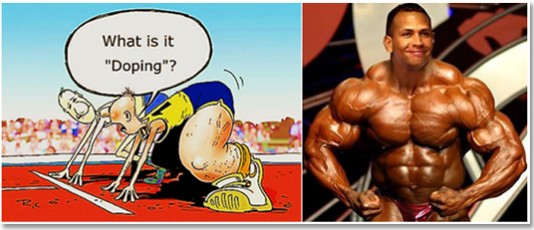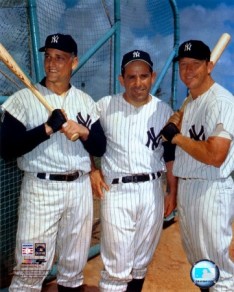 The latest news stories about Lance Armstrong, Alex Rodriguez, and other athletes, initiated the desire to write this article to educate readers about the topic of doping and drugs in all sports.
The latest news stories about Lance Armstrong, Alex Rodriguez, and other athletes, initiated the desire to write this article to educate readers about the topic of doping and drugs in all sports.
While it is not as much as a problem in college sports as in professional ones, it is something that has already reached down to high school and even lower age levels. In Part Two of this article we will look more closely at intercollegiate sports and steroids.
There are many myths thrown around about the relative lack of danger to athletes’ bodies, brains, and general health. There are many people, some doctors included, who are loath to blame, for example, steroids for future medical injuries, diseases, and mental health problems.
To better understand how introducing performance enhancing substances (PEDs) affects body and mind I would suggest reading, especially if a reader has not read them before, earlier articles on ‘How the Brain Works to Regulate Behavior (Motor Activity) and Body State’ and ‘Anxiety and Mental Preparation in Competitive Sports.’ These will help build a foundation for understanding how such substances really work to make such users unhealthy (and possibly much worse) and why they use them. We will first explore how doping and drugs work to increase athletic output.

Jamie Bird – She provides news stories about steroids and their effects.
None of us knows how many asterisks (see Roger Maris, etc.) we could place on sports records because of performance enhancing drugs these days. However, as you will read below, the supposed athletic cheaters were probably not really helping themselves achieve a higher level of performance. If anything, there was a 35 % medical placebo effect – which made the athletic cheater feel as if he had a competitive advantage, but in fact did not.
Doping
The World Anti-Doping Agency (WADA) Code, doping is defined as the occurrence of one or more of the following doping rule violations:
- The presence of a prohibited substance or its metabolites in an athlete’s bodily specimen;
- Use, or attempted use, of a prohibited substance or method;
Performance Enhancing Drugs (PEDs)
PEDs are medications taken by an athlete to improve competitive athletic performance. The classes of PEDs include:
- Stimulants for speed or quickness (caffeine and amphetamine derivatives);
- Analgesics (narcotic and non-narcotic);
- Sedatives used for steadiness (archery for example);
- Steroids for muscle mass increase and supposed power (baseball, football, weight lifting, etc.);
- Erythropoietin (EPO) used to stimulate red blood cell production and potentially oxygen carrying capacity of the body improving tissue oxygen delivery (cycling, swimming, running);
- Masking drugs (epitestosterone) to afford a normal ratio of drug testing testosterone/epitestosterone; and
- Diuretics to decrease the body’s free water and decrease weight (wrestling).
The ancient Greeks used stimulants within mushrooms and ate animal testicles prior to matches (for testosterone). The stimulant drugs supposedly increased aggression and reaction time, delayed fatigue, and caused one to be more alert.
Modern athletes at all stages in all sports have used stimulants in an attempt to improve performance.
Unfortunately, there are no double-blind studies that can confirm or deny improved athletic performance to any measurable degree. The ‘greenies’ or amphetamines taken by baseball players in the 1970’s may actually have been more deleterious than advantageous, especially with chronic use, by wearing down and resetting neuronal receptors within the body. Remember we had to juice the baseball in the 1970s due to low scores. An isolated athlete may, at a single setting have experienced increased athletic performance. However, we will never know for certain, and the fact remains that use of these drugs for a competitive advantage is speculative at best.
Amphetamines used chronically can bring on behavioral changes that look exactly like paranoid schizophrenia. Amphetamines used only on game day will eventually cause behavioral alterations. However, used occasionally, amphetamines will often cause a person to begin to abuse them at other times of stress.

Many of the former New York Yankee greats drank alcohol to excess (e.g., Mickey Mantle, Whitey Ford, and Billy Martin). Interestingly, the rebound hyper-excitability from being in a depressed alcohol induced state would peak in late afternoon or early evening the next day. One can only speculate on athletic production amidst the many variables of genetics, talent, nutrition, mood, training and motivation.
The complex interaction between the body’s hundreds of hormones and neurochemicals and PEDs, supplements, foods, etc., along with varying talent levels and training, remains indiscernible and very speculative. Even drinking coffee or a soft drink with caffeine as a stimulant may have an effect on athletic performance. Nevertheless, we will never really know as to that particular athlete because the swing may be quicker, and just as many balls, if not more, may be missed with caffeine on board by upsetting a batter’s swing tempo.
Generations of athletes have smoked, chewed, and now even use nicotine patches. The stimulant effect of nicotine may specifically offer an increased cascade of stimulating adrenal hormones (epinephrine and norepinephrine). These hormones in an individual may affect blood lactate (the measurable end-product of muscle metabolism from athletic activity).
Reaction time, strength, speed, and endurance may also be affected – with variable effects from chronic and acute use. Smoking before a game may enhance one’s ability to hit a first inning home run. Again, these effects are quite variable and cannot accurately be measured or discerned. Potentially (and inferentially) when smoking became known definitively as unhealthy within our culture, the declining home run production of the 70s led to the so called ‘juiced’ baseball in subsequent years (modifications to its composition that caused it to fly further upon impact). At that time, baseball had to regenerate fan interest and banging homers was the quickest method.
Different foods and their additives have variable effects on mood, sleep, fatigue, energy, strength, and an individual’s metabolism. The athletic effects and medical interactions are too complex to measure due to variable purity of the food or additive itself, amount, time, and setting. All we can do is “play ball” and let it go at that. With respect to stimulants then, we are fretting over drugs that, if anything, hinder an athlete’s performance.
Analgesics include a variety of narcotic and non-narcotic drugs. These drugs may enhance performance by decreasing perceived pain and thereby allowing an athlete to do what he normally could not. Again, this is very speculative and cannot be studied with controls. Within the body’s own analgesic system it remains, very theoretical regarding any confirmed athletic improvement through the application of analgesics.
Steroids are actually potent anti-inflammatory agents in common use in medicine by multiple specialties to treat a variety of diseases. The use of medical steroids is disease and dose dependent, as are the other PEDs drugs.
Nevertheless, playing without pain is significant, and it becomes somewhat of a stretch when an athlete uses steroids for pain when bulk and increased recovery from a tough game is the desired clinical goal. These are gray borderlines regarding health benefits versus cheating to obtain a presumed competitive advantage.
Team physicians and trainers generally do what is expedient to get the athlete’s body back to game conditions. A steroid and local anesthetic injection into a joint during a game may allow one to perform at a high level, whereas prior the athlete could not walk.
This also is a gray area as the line between actually competing itself and taking drugs to enhance performance can be blurry. Is the steroid injection with local anesthetic medical treatment essentially a PED? No, not in the classic sense.
The line becomes even more blurred, however, when one discusses the medical need for these drugs – because many drugs supposedly (but cannot be proven other than by inference) indirectly improve performance (narcotics, high dose Motrin, Toradol injections, as do many others, including “feel good drugs”:
- Such as antidepressants – which have significant effects on stimulating hormones such as dopamine, norepinephrine, epinephrine, and serotonin within the body).
- Athletes, as a group, are not immune to congenital or acquired disorders that require drugs for treatment. In most instances, using testosterone as an example, adding testosterone to a body that does not normally produce enough will not raise the level far above normal (unless measured shortly following its administration). Athletes may be bedeviled by other hormone and transmitter shortages of production.
The distinction between medical treatment and PEDs also wanes when one accuses an athlete of “cheating,” when medically he may need this treatment not just for athletics, but also for life itself. There is no computer that can yet individually evaluate the interactions of non-FDA approved PEDs with variable purities and dosages, genetics, the sport itself, and the many unknowns of appetite, behavior and motivation, mood, and sleep patterns.
Again, there is no EVIDENCE whatsoever that by themselves, these PEDs as medical treatments affect athletic performance other than anecdotally. Modern medical science demands hypothesis, strict scientific methodology, and appropriate statistical analysis independently. PEDs studies essentially are lacking true science when it comes to applying them to any supposed improvement in an athletic contest.
It has been known for decades that the supposed cheating athlete will remain a half step ahead of the drug tests, media, competition, family, team and even their trainers/team physicians. If the athlete who is engaged in wrongdoing wants to attempt to cheat, he or she will.

They will soak the field in the early morning hours, pull the fire alarm or cut the electricity, obtain secret funds from boosters, commit battery on the competition, use cameras to spy, steal catchers’ signals from binoculars in center field, and use every kind of imaginable medical drug or technique in the belief they are obtaining an advantage.
Lombardi said that he had six plays within his offense. Despite the other team probably knowing the play, Lombardi felt thatexecuting correctly should still gain yards.
The Ducks play this way, and their fine execution and consistently high performance, body control, and coolness and patience on the field, suggests quite strongly that there is no substance use on this team (with the possible exception of marijuana which is easily obtained in Eugene). Part Two of this article will look at enforcement at Oregon and at other college institutions, as well as a discussion of steroids and health concerns.
 This refreshing talk was in essence a no-nonsense form of “play ball.” Though none of the drugs discussed above have never proven to be of benefit in an actual athletic competition, the inference arises that they may afford a benefit. Most medical studies support a placebo effect of up to 35 % – so the supposed athletic cheater actually thinks he is improving competitive performance at least to some degree because of the PED. However, who is to know if the athlete in a non-drugged state would have performed worse? We cannot really know.
This refreshing talk was in essence a no-nonsense form of “play ball.” Though none of the drugs discussed above have never proven to be of benefit in an actual athletic competition, the inference arises that they may afford a benefit. Most medical studies support a placebo effect of up to 35 % – so the supposed athletic cheater actually thinks he is improving competitive performance at least to some degree because of the PED. However, who is to know if the athlete in a non-drugged state would have performed worse? We cannot really know.
Taking steroids does not increase eye hand coordination, speed, endurance, or athletic ability by itself. While some of the steroid drugs taken long term will increase muscle mass (thus, weight), at the same time the ligaments and tendon attachments become paper-thin.
I remember, early in my career, a world champion Russian weight lifter who tore his biceps and admitted in his pre-op exam that he used steroids. He was bulky and his bicep was knotted in his mid-arm like a bowling ball. Upon orthopaedic repair, he had essentially a paper-thin bicep tendon that was unable to hold a feather of strength.
There is no clear advantage envisioned with these drugs. It is also extremely difficult to discern drug effects to any scientific degree. Though home run production increased by a select few players in the latter 1990’s and early 2000’s, the rest of the league did not follow suit – at a time when supposedly hundreds of baseball players were using PEDs. Compare baseball players and athletes in other sports during the period 1970-90 and one will note the obviously increased muscle bulk of these athletes. Claiming steroids is the sole factor amidst a changed American diet and advanced weight training by all athletes is likely off target.
An athlete’s bulk and size naturally increases with age. The average American gains 18 pounds between age 35 and 40. Ted Kluszewski at 28 in 1953 (Cincinnati Reds) went from a mere 15 homers to 40, 49, and 47 the next three years. Toward the end of his career, Hank Aaron (Braves) hit 47 in 1971 while sitting 20 games. Davey Johnson (Mets) ballooned to 43 in 1973 from 18 a year before.
One can extrapolate from baseball to other sports regarding PEDs. The fact that an athlete takes human growth hormone (HGH) – which may increase the bulk of muscle mass within an athlete – never has been proven to increase performance. Thin, non-muscular athletes hit golf balls in excess of 300 yards; swimmers with slim builds break records; slender basketball players make all-star teams; and yes, even some small fore/upper-armed baseball players have hit many home runs.
The increased bulk makes one clearly think of Popeye eating his spinach; however, the facts remain regarding home runs, that smaller parks, weaker diluted pitching, juiced baseballs and the fact that home runs are hit by the steroid-sparing upper legs allots multiple variables regarding the effects of PEDs – if any. Again, there has been no respectable science applied to PEDs improving competitive athletic performance - only inferences.
Creatine is a water-soluble natural protein that increases muscle bulk from increased water within muscle tissue. Some studies have suggested borderline statistically significant decreased muscle fatigue and increased ATP levels (energy compounds), but no increased strength or improved athletic performance by any scientific methodology. Again, the Popeye look probably gives a 35% placebo effect. Never mind the strikeouts, poor fielding, and overall decreased athletic performance:
It was home runs that mattered in baseball!
The former East Germany had a record number of lawsuits filed by injured athletes dating back to the 1970’s from the early use of steroids, stimulants, and multiple experimental drugs and supplements. Why would anyone even consider taking a non-FDA approved drug or supplement from a non-medically approved lab? Would the athlete actually think he/she is gaining from this practice? This is a weakness of the mind, irrational thought, and a major ill-advised mental blunder.
Conclusions
Our youth are our future, and athletics is highly regarded in our culture in many ways, with many children participating in them. As humans, we all make mental errors constantly. I find no support for the use of PEDs whatsoever. The reality is that many of the supposed athletic cheaters in fact cheated themselves, obtained no athletic benefit from their actions and risked medical injury, and even death, in the process.
We cannot help improve our youth without educating them regarding the risks involved with the intrusions of unhealthy PEDs – especially steroids or stimulants. It is well established that steroids affect every organ system negatively with chronic use. The skin, hair, lining of the gut (and, thus, the immune system), brain, liver, kidney, cardiovascular and pulmonary, muscle, bones and organs are all affected negatively by steroids. Doctors are now performing total joint arthroplasty (synthetic replacement joint of hip, knee, or shoulder) on steroid users at very young ages. Fertility is negatively affected with steroid use and cataracts in early adulthood have set in. Strokes, acne, breast swelling, and potentially cancer, heart attacks and early death occur with chronic anabolic steroid use. Stimulant drugs lead to addictions, medical injuries and unprecedented behavioral clinical illness (rage, and depression, and a psychotic syndrome that is identical to paranoid schizophrenia).
The PEDs users of the world have usually committed no crime (unless they have broken a law) or tort (civil). They most usually broke a rule of a governing body and thus should suffer penalties appropriately for their blunders.
Endless hearings encroaching on privacy rights is distasteful. Most fans really do not want to hear dirt regarding an athlete in a heavily scrutinized world with media everywhere. Not only can we not discern the truth of some of the reporting, but also the effects of using these drugs has not stood up to any pure science – only inferences (which are not proof at all.
We need to spank these athletes with a penalty of not playing for a meaningful period because of breaking the rules of their sports - not for any benefit they attempted to obtain (which were most likely illusory). We need to teach our youth about the misguided choices PEDs users have made which are harmful to one’s health – many times irreversibly. No records should be asterisked, removed or changed.
The use of any drug most probably did not influence more than likely the measurable outcome of a competitive athletic contest. Sports governing rules are meant to be followed, and the rules are there for good reasons – to protect the sport, fair playing field and insure medical safety. Reasonable penalties for use of these drugs should be followed within the sport – with full knowledge that if anything, we are teaching our youth the purity of the sport and avoiding PED use at a young age to prevent irreversible medical pathology.
In Part Two of this article we will investigate some specific substances and methods, what they do in and to the body, and what side effects exist that may lead to poorer performance, compromised health, and even irreversible negative medical outcomes.
Related Articles:
Chip Kelly Update: Everything's Good Again ...
Chip Kelly Update: Wailing and Gnashing of Teeth
Shock and Awe -- The Oregon Ducks' Football Hangover Effect
Despite Lopsided Score, Georgia State "Never Stopped Believing"
Hope Springs Eternal for Ducks
Incompetent Pac-12 Officials: How Do You Miss ALL of THIS?
NeuroDocDuck (Dr. Driesen) is a doctor who specializes in neurology, and sports medicine. He is an Oregon alumnus, completing his medical education and training in the UK. He has been both a practicing clinician and professor, a well-known and respected diagnostician, an author, and has appeared on national television.
NeuroDocDuck is active in his profession, and stays current on all new trends in his field. He enjoys golf and loves his Ducks!
